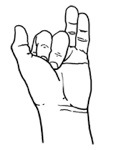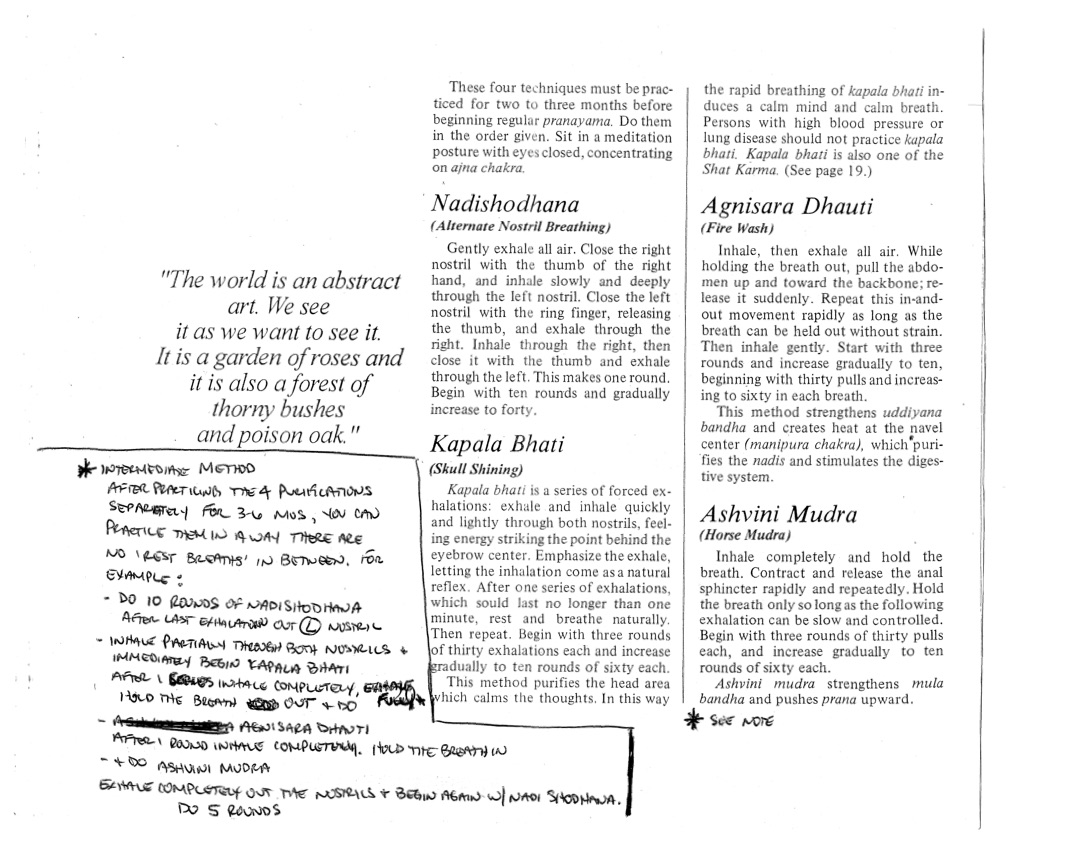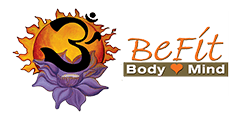These breathing exercises I first learned from Nancy Gilgoff, she learned them from Baba Hari Dass. They are in the book “Ashtanga Yoga Primer” by Baba Hari Dass. They are known as “The Four Purifications” and help to clear the mind of stress and leave the body in a relaxed, content feeling; they are generally safe for everyone, but of course not recommended during pregnancy. They are 2 breathing exercises and 2 bandha exercises.
Nadi Shodhana (Nadi = nerve shodhana = cleansing)
Alternate nostril breathing (without khumbaka or breath holds).
To alternate the nostrils you use a special mudra — mudras are attitudes of energy flow intended to link our prana with universal prana. Mudra can also be traced to the root word “mud” meaning delight or pleasure, and dravay or dru which means to draw forth. Mudras are defined as a seal or short cut or circuit bypass.
The mudra for Nadi Shodhana breathing exercises is called Vishnu Mudra — it makes the closing and opening of nostrils smooth and efficient. 
Vishnu Mudra (hand gesture of Lord Vishnu) This is one of the hand gestures used to alternate the breath through the nostrils during Nadi Shodana. In this mudra the right hand is used as it is associated with giving while the left is associated with receiving. However if for whatever reason you need to use your left hand during practice that is fine. The thumb and fingers rest lightly so very little movement is needed to close each side during practice.
Vishnu is the Hindu God who preserves the universe. He does this through an interplay of opposites; creation and destruction, male and female, dark and light. Uniting these qualities through yogic practices helps us keep a balance in our lives and live with more understanding of others and how we relate to them.
Alternate nostril breathing is about bringing balance in our body and mind — balance in being extroverted and introverted, balance between our feminine and masculine sides. The mudra used for this is appropriately named after the god responsible for helping us with this balance.
Nadi Shodhana in the four purifications – you place your right hand in Vishnu Mudra position on either side of your nostrils, your breath should be deep and slow;
- Inhale Left (closing the right nostril with your thumb), exhale Right (closing the the left nostril with your ring finger), Inhale Right, Exhale Left = L R R L. This is one round.
- Start by performing 10 rounds and gradually increase to as many as 30 rounds.
You can use your left hand for counting, at the start of each round use a finger to keep track of how many you have done.
Kapalabhati (Kapalabhati = Forehead Shining). This is very different from our yogic breath, here we are make the sound of our breath at our nose (instead of our chest).
You pump your diagraphm and abdominals sharply and quickly on the exhale and relax on the inhale, practice this by coughing — we do a similar contraction of the diaphragm when coughing except a cough is through the mouth — we are keeping the breath through the nose here. Normally we relax on the exhale, instead here we pump the diaphragm on the exhale, which will help to strengthen your diaphragm.
Kapalabhati helps to propel the breath upward toward the skull where it helps to detox the brain through the glymphatics, and in the process the lymphatics in the abdomen also get a massage helping them to move and detoxify as well.
Purposeful forceful breathing helps to use all 5 lobes of the lungs — especially helps us to use the lower lobes of the lungs where we can access more oxygen rich blood increasing oxygenation which helps with detoxification and fat burning, and increasing vascularization in the lower lobes of the lungs.
How to perform:
- Take a slightly deeper inhale; exhale pump at a steady rhythm for about 30 exhales. Pace does come into play, I like a steady pace of about 15 seconds give or take to do the 30 pumps. Some like a faster pace, and some even slower.
- If you are new to this, start with less. To progress you can increase your pumps in each set (I have seen text books recommend as many as 500! -that is a bit much for me but under certain circumstances it may have a powerful healing effect).
- take a recovery breath or two
- repeat for a total of three rounds.
Kapalabhati helps to clear your mind and calm your thoughts, reducing stress. I literally feel like its sweeping debris from my brain.
Working with the bandhas in the last 2 purifications
This first exercise should not be done during menstruation, if you think you are pregnant or if you are trying to become pregnant.
Agnisara Dhauti (Agni = Fire, Sara = Cascade, Dhauti = Purification)
Take a deep inhale, then exhale all air out and hold. If this is new to you, do this a couple times to get used to holding your breath out.
Once you are comfortable holding your breath out, take a deep inhale, and exhale hold — lean forward place your hands on your knees — lift and drop your abdomen — suck up your abs and let them drop — as many times as you can while comfortably holding your breath out.
- Work up to 30 pulls — when you’ve done a comfortable number
- Inhale and release, take 1 or 2 recovery breaths and repeat.
- for a total of three rounds
Agnisara Dhauti strengthens your connection to uddiyana bandha, purifies your 3rd chakra, stimulates our digestive fire, and eliminates constipation.
Ashvini Mudra (Ashwini = horse Mudra = gesture or attitude)
Ashvini means horse, the posture is named after a horse since the horse does this gesture after going to the bathroom.
How to perform:
- Inhale completely and hold your breath in,
- contract and release the anal sphincter rapidly and repeatedly, only as long as you can comfortably hold your breath.
- Work up 30 pulls
- Exhale, take 1-2 recovery breaths and repeat
- for a total of 3 rounds
Ashvini mudra strengthens the pelvic floor, improves our connection to mula bandha and pushes prana upward, slowing down the aging process. This mudra can also be used to heal problems such as hemorrhoids and constipation.
Putting them all together:
After practicing all 4 purifications for 3-6 months you can put them together and practice them in a way that there are no “rest breaths” in between. For example:
- Do 10 rounds Nadi Shodhana, after last exhale out Left nostril
- Inhale partially through both nostrils and begin kapalabhati for 1 round of 30 breaths. After 1 series inhale completely, exhale fully and HOLD your breath out
- do Agnisara Dhauti for 30 pulls, inhale completely and HOLD your breath in
- do Ashvini Mudra for 30 pulls. Exhale completely and begin again with Nadi Shodhana.
Do a total of 5 rounds in this way.
I performed these four purifications as part of my meditation practice for years before I learned the Pranayamas from Nancy. I enjoyed doing them and miss them now that I do pranayama instead. It was fun to do them again this month.
The four purifications practice prepares you well for pranayama, improves your connection to your bandhas, and improves your breathing.

From the book “Ashtanga Yoga Primer” by Baba Hari Dass
ONE MINUTE MEDITATION with Bhastrika (bhastrika = bellows)
Lastly I want to share with you a quick breathing exercise to clear your thoughts and energize your brain. Bhastika breathing keeps you very involved with your breath — your are pumping your breath on both the inhale and the exhale like a bellows.
- Breathing this way for a short period of time pumps oxygen into your brain which allows your brain to feel from your heart rather than think from your mind or what you are thinking. Let your heart be in the driver’s seat for a moment 🙂
- Often times this pumps enough energy into your nervous system and circulatory systems to give you the ability to settle your mind and feel some calm.
It is a simple breathing exercise that can be done anywhere, anytime. We are getting familiar with it because you will learn it in pranayama with breath holds.
It is especially good to use if you are getting ready to face a stressful situation or need to clear your mind or calm your nervous system. How to perform:
- Inhale deeply and begin to pump your breath in and out – Breathing deeply through your nose, in and out, using all five lobes of your lungs like a big bellows.
- Use your lungs in and out as much as you can feeling your rib cage expand on inhales and contract on exhales.
- Do 30 blasts.
- Then do our normal yogic loud breathing (some call it Ujjayi) slowly (about a 5 second inhale and a 5 second exhale) for 5-10 breaths. Repeat if you have time (you can lengthen the time of ujjayi breathing if you have more time or if you plan to do several rounds of this).
When we use all of our lungs, especially our lower lungs, like in bhastrika, we activate calm receptors that soothe our nervous system.
